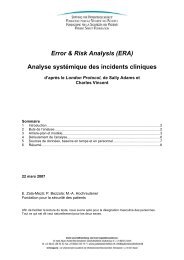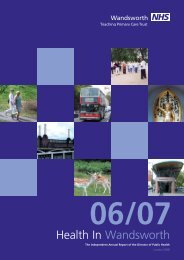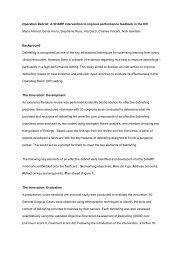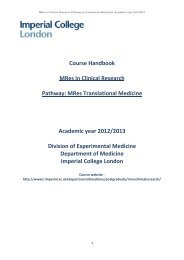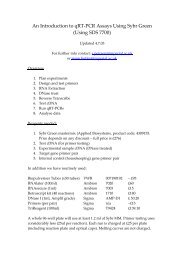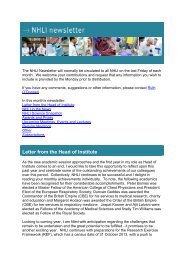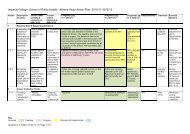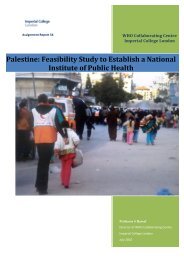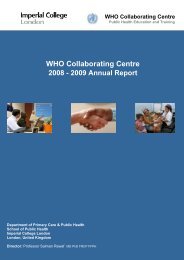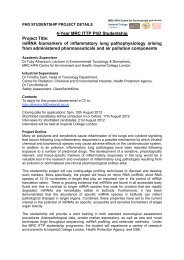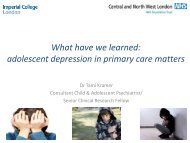Risk factors for healthcare-associated urinary tract infection and their ...
Risk factors for healthcare-associated urinary tract infection and their ...
Risk factors for healthcare-associated urinary tract infection and their ...
- No tags were found...
Create successful ePaper yourself
Turn your PDF publications into a flip-book with our unique Google optimized e-Paper software.
222C. King et al. / Journal of Hospital Infection 82 (2012) 219e226Table ISummary of the studies identified as a result of the systematic literature reviewStudy design Critical Appraisal Skills Patient population Country Data source (electronic) Reference (year)Programme Score (total)Caseecontrol 6 (12) General Saudi Arabia Patient records 20 (2004)Caseecontrol 8 (12) Hip Sweden Patient records 21 (1999)Caseecontrol 9 (12) General UK Study/surveillance 22 (1999)Cohort 5 (14) Paediatric India Study 23 (2011)Cohort 9 (14) Transplant Brazil Study 24 (2006)Cohort 11 (14) Spinal Spain Study 25 (2000)Cohort 12 (14) General Australia Study/patient records 26 (2007)Cohort 10 (14) Orthopaedic Spain Study 27 (2001)Cohort 10 (14) ICU Canada Linked records (e) 29 (2002)Cohort 8 (14) ICU Canada Linked records (e) 30 (2005)Cohort 9 (14) ICU France Study 31 (2003)Cohort 9 (14) Stroke USA CASPR 32 (2006)Cohort 8 (14) Paediatric USA Patient records 34 (2009)Cohort 13 (14) Surgery Spain Patient records 35 (2003)Cohort 6 (14) General USA Study 28 (1986)Cohort 12 (14) ICU France Study 33 (2001)Prevalence 5 (12) General UK Prevalence survey 4 (2008)Prevalence 11 (12) General Germany Prevalence survey 36 (1997)Prevalence 5 (12) General Israel Patient records 37 (2005)RCT 8 (14) General USA Study 41 (1986)Surveillance 3 (12) ICU USA Patient records 38 (1999)Surveillance 6 (12) General Egypt Study 39 (2010)Surveillance 12 (12) ICU France Surveillance 40 (2008)ICU, intensive care unit; CASPR, Cali<strong>for</strong>nia Acute Stroke Pilot Registry; RCT, r<strong>and</strong>omized controlled trial.For each study included in the analysis, the study design, the Critical Appraisal Skills Programme (CASP) score <strong>and</strong> the study setting aredescribed. CASP scores are presented together with the total possible score (in parentheses). The data source describes the origin of the dataused by the included study <strong>for</strong> <strong>their</strong> statistical analysis, with ‘study’ meaning either that the data was collected <strong>for</strong> the purpose of the researchpublished, or that there was no further clarification on the origin of the data. An ‘e’ in parentheses denotes that the data used were electronicor automated, instead of using paper patient records or manual searching.Of the 35 risk <strong>factors</strong> <strong>for</strong> which PAR% values were calculated,functional independence (measured as the level ofassistance required with daily living tasks) was found to havea non-significant PAR% (1.47, 95% CI 0.62 to 3.55), despitebeing identified as an independent predictor of HCA UTI. 25 Theremaining 34 significant risk <strong>factors</strong> were stratified into a hierarchy,with the risk factor with the highest PAR% (79.34%, 95%CI 78.18e80.50) being <strong>urinary</strong> catheterization (Table II). Fiverisk <strong>factors</strong> demonstrated protective properties from thecalculated PAR%: creatinine level



